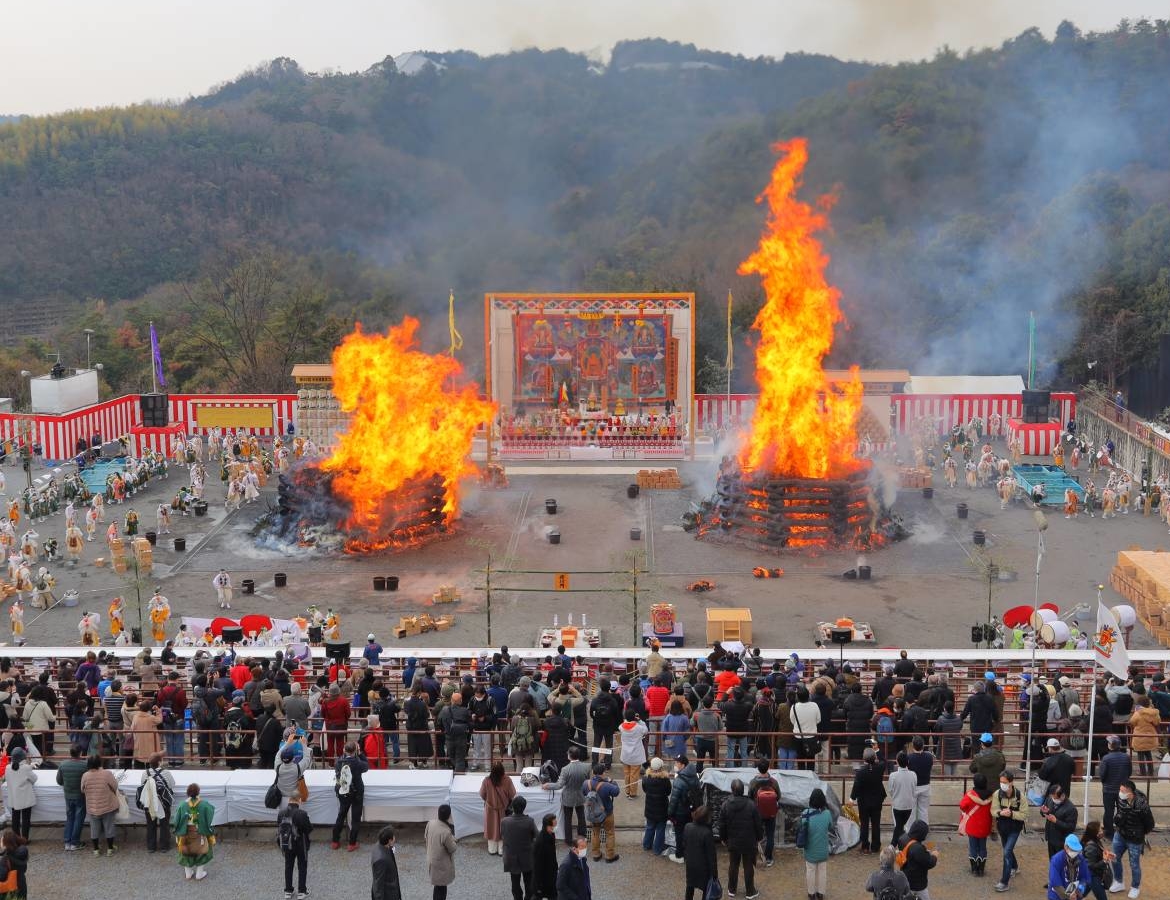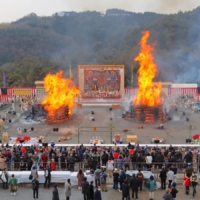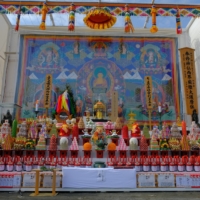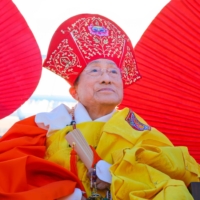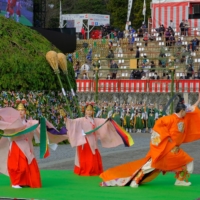A long procession of people dressed as yamabushi mountain priests makes its way into an amphitheater in the hills of eastern Kyoto to the sound of majestic symphonic music. This is how the Agon Shu Buddhist Association’s annual Fire Rites Festival always begins. But this year there were some very visible differences from previous years. The yamabushi kept a careful distance from each other, for example. And looking closely, you could see that each one was wearing a small transparent plastic face shield.
These were just some of the precautions taken against the coronavirus during the association’s 48th annual Fire Rites Festival — the biggest event of its kind. Each year the Agon Shu faithful gather to pray for health and world peace. But during the pandemic there was a special emphasis on praying for an end to the pandemic, as well as asking for divine intercession to achieve peace and ensure disaster preparedness.
Taking precautions
The organizers of the 2021 edition of the festival, which was held on Feb. 7, took precautions such as requiring participants to maintain social distancing to minimize the risk of viral transmission. And members of the faithful who opted not to attend the event during the state of emergency in effect in Kyoto and other Japanese prefectures, were able to take part virtually thanks to a high-speed internet link.
But despite that, and the grim reality of the pandemic weighing on everyone’s minds, the Fire Rites Festival was held in much the same way as in previous years, in an atmosphere of celebration and religious devotion.
Occupying a place of honor in the yamabushi procession was a bier that bore the ashes of the Rev. Seiyu Kiriyama, the founder and first president of the association. Kiriyama passed away in 2016, but his personality and single-minded devotion to spreading the Buddha’s message of salvation continue to inspire the Agon Shu faithful. A solemn hush descended on the amphitheater as recordings of Kiriyama’s sermons and prayers were played back through loudspeakers.
Original teachings
The doctrine Kiriyama spread during his years as the head of Agon Shu was one he found after a long and arduous search for spiritual truth, which culminated with his founding of the association in 1978. Kiriyama’s search took him all the way back to the original teachings of the Buddha, which he found in the Agama Sutras, the original and purest source of Buddhist wisdom.
There are three key articles of faith for Agon Shu believers. First is the Lord Buddha — the ultimate object of worship. Then there are the Buddha’s teachings and training methods, known as the dharma. And finally, there is the community of believers and its leaders, known as the sangha. The Agon Shu Buddhist Association is an example of a sangha.
Agon Shu is what is known as a “broad church,” or to put it in academic terms, the association’s doctrine is syncretic. It draws on teachings and practices from Buddhism’s three main schools, including elements from the Tibetan and Bhutanese traditions, as well as Taoism and Japan’s homegrown Shinto tradition.
Dispelling the gloom
As if to dispel the gloom that many people felt because of the pandemic, the weather on Feb. 7 was warm and sunny, with hardly a cloud in the sky. Blowing on conch shells, the yamabushi assembled in front of the large, richly decorated altar as some of them beat out a rhythm on taiko drums. The soundscape then gave way to the beautiful and otherworldly music of composer Hideki Togi, who carries on the traditional music played at the imperial courts and shrines in Japan.
Besides the colorful and imposing altar, the amphitheater was dominated by two gomadan pyres. Each of them was 11 meters wide and seven meters high. One was the bukkaidan, for the liberation of the spirits of the departed, while the other was the shinkaidan, for the prayers, requests and desires of the living. Covered in green boughs, they seemed to be waiting patiently to be set ablaze.
But before that happened, Agon Shu members conducted a series of sacred rituals to ensure the success of the day’s proceedings. A trio of dancers — two women and a man — wearing brightly colored ancient court costumes or shrine maiden costumes performed stately bugaku dances.
Cleansing rituals
Rituals featuring members of the faithful wielding a sacred sword, a ceremonial ax and bows and arrows were then conducted to dispel evil and purify the venue. There then followed, as in past years, a mondo question-and-answer exchange on religious doctrine performed by several of the yamabushi-clad faithful. As you might expect, the focus of this year’s exchange was the coronavirus pandemic and what Agon Shu is doing to help combat it.
Then came the moment everyone had been waiting for. Four attendants set long torches alight and inserted them in apertures at the base of the gomadan pyres. A few moments later, thick gray smoke began to billow out of the pyres, followed by bright orange flames bursting forth from the top of the gomadan. A wave of warmth spread out from the pyres as the sound of taiko drums and sacred chants reverberated throughout the amphitheater. Yamabushi then began throwing gomagi prayer sticks, on which people write their personal prayers and desires, into the flames. A total of about 29 million gomagi were burned in this year’s Fire Rites Festival.
Memorable experience
One big difference between this year’s event and past festivals is that some worshippers were allowed the privilege of throwing their own prayer sticks into the flames. This writer was one of the fortunate few, and it was a uniquely memorable experience. When offered this opportunity, the question as to what one should write on the prayer stick naturally arises. “May everyone be happy and healthy” was the writer’s choice. An obvious, and even banal, sentiment, perhaps, but one that is nevertheless worth expressing, in the hope that it may be realized through some form of divine intercession. At the very least it offers the supplicant a chance to focus his or her thoughts on what is truly important amid the confusion and distractions of our earthly existence.
Having written one’s wish on the prayer stick and tying it to a small bundle of wood to give it the heft needed for it to be cast into the flames, the next step was to enter the section of the amphitheater where the gomadan pyres are located. One suddenly becomes aware that one is now a participant, in the truest sense of the word, in the fire rites ceremony, and not a mere observer.
Seen up close, the gomadan are imposing and awe-inspiring. Then the moment comes to toss the prayer stick into the bonfire, and as it arcs toward the flames, one makes a silent prayer that the pandemic will pass, and that all of us will indeed be happy and healthy in this uncertain and ever-changing world with the help of the Lord Buddha.



